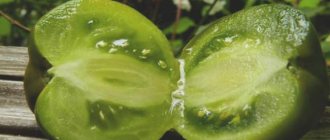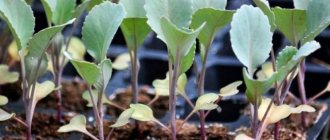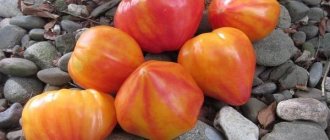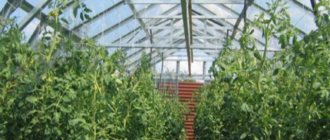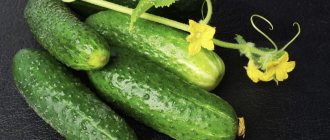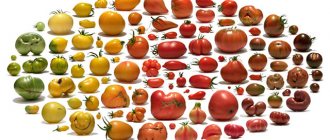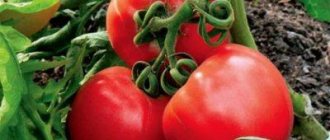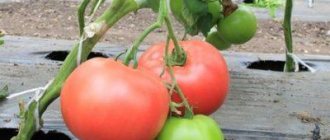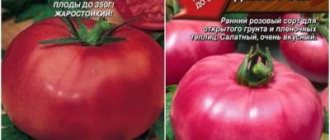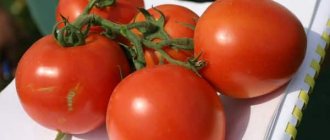Description and characteristics of the variety
Tomato Tsarevna is a determinate mid-season hybrid. The fruits begin to ripen 110-115 days after the sprouts appear. The variety is intended for cultivation in open ground or under film cover. In the southern regions it is grown mainly in gardens, and in the northern regions - in greenhouse conditions.
The bushes are medium-sized, reaching a height of 80-90 cm. Young plants are densely strewn with dark green foliage. The stems are strong, from 2 to 6 inflorescences are formed on each side shoot. 6-7 fruits are formed on the hands. The main trunk and side shoots stop growing when several flower clusters appear on the plant.
The fruits of the Tsarevna variety have an elongated cylindrical shape. As they ripen, they become bright red and reach a weight of 60-90 g. The skin is smooth and dense. Fruit cracking occurs extremely rarely. The taste of the pulp is sweet and there is a pronounced aroma. It is characterized by a high dry matter content.
The productivity of the Tsarevna tomato is 7-7.5 kg per 1 m2. The fruits are stored for a long time without loss of taste. Thanks to their thick skin, tomatoes are not damaged during long-term transportation.
Hybrid characteristics
The tomato bush is of medium height, reaching 1.5–1.7 meters in length. Determinate, grown in 1 or 2 stems, the stem is powerful. Early ripening, only 100 days pass from seed germination to the first ripe tomatoes. Although the bushes of this hybrid are limited in growth, they are still pinched and formed into one or two stems.
The foliage of the bush is average; when growing in a greenhouse, the lower part of the plant is removed all the green mass, 3-4 leaves are left on top to protect the plant from ultraviolet rays. 4–5 clusters with 5–8 tomatoes per cluster are formed on the bush. The yield is high - up to 5 kilograms of ripe fruit can be removed from the bush. 3-4 plants are planted on one square. In an open area, the growth and ripening of fruits is more stable than in a greenhouse.
Description of the fruit - ovoid or elongated, fruit weight from 150 to 240 grams. The color of unripe fruits is light green, ripe ones are red. When ripe, there is no green spot on the stalk. When cut into the pulp, 3 seed sacs are formed. The pulp is juicy and red in ripe vegetables. When harvested, yellow tomatoes turn yellow.
The taste is excellent. It has a pronounced tomato taste with a slight sourness and a pronounced tomato aroma. Fresh salads are prepared from the fruits of the hybrid, used for pickling and making juice sauces.
The variety resists bacteriosis, tobacco mosaic virus and Alternaria.
See also
Characteristics and description of the King of Giants tomato variety, its yieldRead
Advantages and disadvantages
The advantages of the Tsarevna tomato include the following qualities:
- good keeping quality and transportability;
- excellent taste;
- resistance to verticillium and tobacco mosaic;
- ease of care;
- high productivity;
- friendly fruiting.
Among the disadvantages of the variety, susceptibility to fungal diseases is noted.
Advantages of the variety
This type of tomato is disease resistant. Namely, verticillium and tobacco mosaic virus. The fruits practically do not crack, with rare exceptions.
There are about seven kilograms of harvest per square. High fruit set. All these are also big advantages of the variety. The Tsarevna F1 tomato tolerates long-term transportation well without loss of taste. The trunk and side shoots interrupt the growth process when flower clusters appear. One brush can grow up to seven shoots. The look is not fussy to care for.
One important drawback: susceptibility to fungal diseases.
Purpose
Thanks to their excellent taste, the fruits of the Tsarevna variety are good fresh. Tomatoes add bright color and pleasant aroma to salads. The peeled pulp is added to the borscht dressing.
The fruits are used for pickling and canning. They are rolled into jars whole or in slices. Juice and winter salads are prepared from ripe fruits. Barrel tomatoes do not lose their sweet taste and acquire a delicate sourness.
Peculiarities
“Frog Princess” is a representative of green-fruited tomato varieties with medium early yield. The first fruits can be harvested after 110-115 days from germination.
Description of the plant:
- A powerful plant with abundant succulent foliage.
- The bushes reach one and a half meters in height.
The characteristics of the variety make it possible to grow tomatoes both in a greenhouse and in open ground, but when planting it is worth taking into account the capriciousness of “Frog” to weather conditions. She loves warmth, so it will grow and bear fruit much better in greenhouse conditions.
- It is characterized by high productivity, under favorable development conditions, from 1 sq. m. it is possible to harvest up to 6.5 kg of tomatoes.
- Tomato is quite resistant to many diseases.
Description of fruits:
- Medium size, flat-round shape, with slight ribbing.
- On average, tomatoes weigh 150-250 grams.
- The color of the ripe fruit is green with a bronze tint.
- The skin is thin and tender.
- Rich fruity tomato aroma.
- The pulp is juicy, multi-chambered, natural green in color.
- The taste is exquisite, extremely pleasant and very sweet.
Numerous reviews from those who have already planted and grown the “Frog Princess” make it clear that not all of its characteristics are beautiful; this variety also has its disadvantages.
Flaws
- It is quite difficult to determine the ripeness of a tomato and to remove it from the bush in time.
- An unripe fruit has a sour taste, but an overripe one turns the pulp inside into mush and can even fall apart right on the hand.
- It is also important that tomatoes of this variety are completely unsuitable for storage and are very difficult to transport, easily wrinkle and spoil.
- They should not be grown for the purpose of subsequent preservation; “Frog” is only suitable for fresh consumption.
See also
Characteristics and description of the Bella Rosa tomato variety, yieldRead
But tomatoes with a protective green color will not attract those who like to make money at someone else’s expense.
Diseases and pests
The Tsarevna variety is resistant to tobacco mosaic virus and verticillium. Plants can be affected by the following diseases:
- late blight;
- septoria;
- macrosporiosis;
- top rot.
Insect pests sometimes settle on tomatoes:
- Colorado beetle;
- root-knot nematode;
- wireworms;
- scoops.
A lack of boron and iron in the soil provokes the appearance of chlorosis. Against the background of calcium deficiency, blossom end rot develops, especially in combination with high humidity.
general characteristics
The color of the fruit is bright red, ripens in 110-115 days. “Tsarevna F1” is a mid-season tomato variety. The weight of one mature fruit does not reach one hundred grams (from 50 to 80), the bush grows up to 100 cm in height, and is considered a low-growing variety. “Tsarevna F1” is used for planting in greenhouse, closed or ground conditions. Can be used fresh for salads, or for canning or pickling vegetables. The fruits of “princess F1”, in addition to taste, give the salad a beautiful bright color and a pleasant smell. High yield (7-7.4 kg per square)
The bush requires certain, simple care: it needs to be tied up, requires pinching, regular hilling, watering, fertilizing, fighting parasites and diseases.
Seeds for seedlings are planted sixty days before planting in the ground.
Insects that can attack fruits:
- Colorado potato beetles;
- root-knot nematodes;
- wireworms;
- scoops.
Growing seedlings
Mid-season varieties are sown for seedlings 55-60 days before the expected date of transplantation to a permanent location.
Tsarevna tomato seeds are planted in special containers in the second decade of March, and under cover in early April. Important!
Planting seeds too early causes the sprouts to stretch out. Such plants do not take root well, and subsequently there is a decrease in yield.
The seeds are immersed in warm water in advance to swell so that shoots appear faster. To disinfect, they are immersed in a 1% solution of potassium permanganate for 10-12 hours. This treatment will prevent the development of fungal diseases.
Loose, fertile soil is poured into boxes with drainage holes. Make grooves at a distance of 4 cm from each other. The seeds are laid out in moist soil, retreating 2-3 cm. The crops are sprinkled with earth and covered with plastic wrap. Seeds can be germinated in a greenhouse. They are planted in the same way as in boxes. The optimal temperature for seed germination is +20…+25°C.
Containers with crops are placed in a warm, bright place. As soon as the first shoots appear on the surface, the cover is removed. The night air temperature is reduced to +16...+18°C, and the lighting intensity is increased. Water the seedlings moderately, because Often when the soil is waterlogged, plants are affected by blackleg. For irrigation use warm, settled water. In the phase of 2-3 full leaves, seedlings dive into cups or a greenhouse.
During active growth, tomatoes consume large amounts of microelements. Before planting seedlings, fertilizers are applied 2-3 times with intervals of 14-16 days. For this purpose, complex fertilizers and home-made fertilizers are used. Rotted manure, green mash, wood ash or an infusion of bird droppings are used as components.
On a note!
To prevent the seedlings from bending towards the light source, the boxes must be rotated periodically.
Tomatoes are transplanted into a greenhouse in the first ten days of May, and into open ground in early summer, when it gets warmer and frosts stop. In order for plants to easily adapt to new conditions, it is recommended to harden them for several days. To do this, the seedlings are taken outside. The duration of hardening depends on climatic conditions.
About the Swan Princess tomato: rules for planting, care, cultivation, propagation
Varietal tomatoes from Russian breeders are increasingly surprising gardeners. The breeder of the NPO "Gardens of Russia" managed to obtain high-yielding tomatoes from crossing two varieties, which have become well established in Russia in open garden beds and in greenhouses. This tomato is called Swan Princess f1.
An early-ripening, productive hybrid bred by Myazina L.A. The period from germination to the beginning of ripening is 95-105 days. You can grow this tomato both in greenhouses and in open ground with a garter to a support or trellis.
The plant height at the end of the season in closed ground is 150-180 cm, in open ground it is lower. We recommend forming this tomato into 2-3 stems, removing all unnecessary numerous stepsons. The brush of this hybrid is simple, with 5-6 ovaries.
Basic qualities of fruits
The fruits are elongated cream with a small spout, pink-raspberry color at maturity, weighing 150-250 grams, pleasant tomato taste with a slight sourness. The skin on the tomato is thin. These tomatoes are suitable for canning, pickling, and processing. If they are ripened on the bush, then the taste is as close as possible to varietal tomatoes.
The hybrid is included in the state register of breeding achievements in the Russian Federation.
Features of cultivation, planting and care
We recommend sowing the seeds of this tomato for seedlings 60-65 days before the intended planting in the ground. When planting seedlings in a permanent place per 1 sq. Place up to 4 plants per meter of prepared area.
Further care for tomatoes involves pinching, removing weeds, timely watering and preventive treatment against diseases and pests.
The author of the hybrid recommends that after pouring 4-5 brushes, cut off the top, leaving 2-3 leaves above the last brush.
Tomatoes Swan Princess on video
If you grew Swan Princess tomatoes, write whether you liked them or not. What advantages and disadvantages does this tomato have in your opinion? If possible, post a photo of your harvest. Thank you!
Your reviews about the Swan Princess tomato will help many gardeners evaluate it objectively and decide whether to plant it or not.
If the garden plot is located in an area with an unfavorable climate, it is very difficult to choose a suitable variety of tomatoes for open ground: it must combine sufficient cold resistance, early ripening, good yield and resistance to temperature changes and diseases. The requirements for tomatoes grown in the northern regions are very high, but the hybrid tomato Tsarevna Swan F1 meets them.
The Swan Princess hybrid was bred by breeders of the NPO "Gardens of Russia" in the Kurgan region and classified as part of the "Miracle Tomato" series. It includes the best tomato hybrids that can be grown both in protected and open ground, even in the coldest regions of the country.
Tomato Princess Swan
Features of agricultural technology
Landing. You can plant the Swan Princess both in a greenhouse and in open ground. However, when grown indoors, the hybrid does not reveal its full potential. It is when planted in the open air that the fruits acquire their distinctive characteristics - taste and aroma.
The recommended planting pattern involves a checkerboard pattern, maintaining a distance of 40-50 cm between neighboring seedlings. Thus, no more than 3-4 bushes are planted per 1 m2.
Care. After an adaptation period, seedlings form. It is recommended to grow the hybrid with 1-2 stems; if desired, 3 can be used. A garter to the trellis is required. The bushes are prone to the formation of fattening shoots, so the Swan Princess needs periodic pinching and, in greenhouse conditions, pruning of the lower foliage.
Advantages and disadvantages of the Swan Princess hybrid
The variety has a large number of advantages:
- high resistance to cold, temperature changes, stress, diseases;
- taste characteristics of fruits and the versatility of their use;
- wide choice of landing sites;
- good keeping quality and transportability of fruits.
The disadvantage of tomatoes can be considered the need for pinching, but many gardeners, on the contrary, evaluate this as a plus and receive additional planting material by rooting cut shoots.
https://dachamechty.ru/tomat/uhod/tsarevna-lebed.html https://tomatland.ru/catalog/10181 https://7ogorod.ru/pomidory/carevna-lebed.html
Transplanting seedlings
The land for planting tomatoes has been prepared since autumn. They dig it up and add fertilizers: humus, peat and wood ash. For growing tomatoes, soil with the addition of plant residues is suitable: leaves, hay and last year's tops. In spring, 25-30 g of superphosphate and 35-40 g of potassium fertilizers are applied per 1 m2 of area.
Tomato Tsarevna grows well in southern, southwestern or eastern areas. It is not recommended to plant it after potatoes or peppers. The best predecessors of tomatoes are onions, cucumbers, zucchini and cabbage. They are planted in the same place for no more than 3 years in a row.
The holes must correspond to the size of the root system. Before planting the plants, the hole is well watered and organic fertilizer is added. Plants are placed at a distance of 40 cm from each other. In this case, the row spacing should be at least 50 cm. Young plants are planted with a clod of soil in which they grew. The stems are buried to the level of the first leaves. The soil around the seedlings is compacted and watered well.
Formation of bushes
The process of forming a bush consists of timely removal of stepsons and pinching the top of the shoot. Most often, tomatoes of the Tsarevna variety are grown in 2-3 stems. The bush is formed as follows:
You may be interested in: Dates for planting tomato seedlings in open ground and greenhouses according to the garden calendar Favorable days for planting tomatoes for seedlings in 2021 according to the lunar sowing calendar Favorable days for picking tomatoes in 2021 after germination: timing of picking tomato seedlings in the table by day
- On the central trunk, 2-3 lower stepsons are broken out.
- 1-2 of the strongest side shoots are left on the bush. They will grow along with the central stem, forming flower clusters and ovaries.
This pinching allows you to maximize the yield of the crop and extend the fruiting period.
Main characteristics of the variety
The Frog Princess is a representative of medium yield. The first fruits can be collected after 3.5-4 months.
Description of the variety:
- the plant is very strong and has very succulent leaves;
- the height of the stem can reach 1.5 m;
- under favorable growing conditions and appropriate weather conditions, about 6-6.5 kg of fruit can be collected from 1 m²;
- There is excellent resistance to most known diseases.
The plant is excellent for growing both in a greenhouse and in open ground. However, when planting outdoors, you should understand that the Tsarevna Frog variety is very picky about weather conditions and needs a constant abundance of heat.
That is why planting in open ground should be carried out only if you are confident in the weather conditions for the season - in this case, there is an excellent chance of growing a good harvest.
Characteristics of the fruits of the Tsarevna Lyagushka tomato variety:
- medium size, spherical shape, slightly flattened at the poles, slight ribbing in the texture can be observed;
- the average weight of 1 tomato is about 200 g;
- When ripe, tomatoes acquire a green color with a slightly brown tint;
- the skin is thin and soft;
- Tsarevna Frog tomatoes have a very rich smell that is slightly reminiscent of fruit;
- tomatoes have juicy, rich green flesh;
- the sweet and unique taste cannot be confused with anything else.
See also
Characteristics of the tomato Star of Siberia f1, advantages of the hybrid and agricultural cultivation techniques
Read
The catalogs have a large number of photos in which you can examine the tomato in more detail.
Stepsoning
During pinching, shoots that form in the leaf axils are removed. This procedure allows you to reduce the density of the bushes and reduce the consumption of nutrients by the side stems. Regular removal of stepsons allows you to direct the flow of useful microelements from the root system directly to the fruits, which speeds up the process of their ripening.
Pruning is carried out in the morning, when plant tissues are maximally saturated with moisture. Until the evening, the surface of the damage will dry out, and bacteria entering it will not harm the tomatoes. Together with the stepsons, the lower foliage on the main trunk and remaining shoots are removed. It is recommended to cut no more than 3 leaves in one procedure. Free air circulation reduces the likelihood of developing fungal diseases.
On a note!
Leaves should not be removed above the third flower cluster.
When stepsoning, it is important to follow these rules:
- Removing side shoots must be combined with tying the tomatoes to a support.
- The procedure must be carried out before the first cluster begins to bloom.
- The length of the stepsons should not exceed 4-5 cm. Such shoots are easily torn off, and the resulting wounds quickly heal.
- If time is lost and the stepson has outgrown, it is advisable to leave the stump after removal, because large lesions on the main trunk serve as entry points for infection.
- It is recommended to carry out pinching only in dry weather. On the eve of the procedure, you should not water or feed the tomatoes.
The Swan Princess - Practice of dacha farming by Elena Golnikova
Mid-season (110-115 days from germination to ripening), determinate, racemose tomato hybrid for open ground and film shelters.
Bush 0.9-1 meter high, with a regular leaf. Requires tying to the support and pinning. The best result is obtained when the plant is formed into 2-3 stems.
The fruits are elongated-cylindrical, smooth, dense, with a strong skin, red in color at maturity, weighing 60-90 grams, good (for a hybrid) taste. These tomatoes are well suited for pickling, whole-fruit canning, as well as fresh consumption. They have good shelf life and transportability.
The hybrid is resistant to verticillium and tobacco mosaic virus.
Tomato Tsarevna is a determinate mid-season hybrid. The fruits begin to ripen 110-115 days after the sprouts appear. The variety is intended for cultivation in open ground or under film cover.
The bushes are medium-sized, reaching a height of 80-90 cm. Young plants are densely strewn with dark green foliage. The stems are strong, from 2 to 6 inflorescences are formed on each side shoot. 6-7 fruits are formed on the hands.
The fruits of the Tsarevna variety have an elongated cylindrical shape. As they ripen, they become bright red and reach a weight of 60-90 g. The skin is smooth and dense. Fruit cracking occurs extremely rarely.
The productivity of the Tsarevna tomato is 7-7.5 kg per 1 m2. The fruits are stored for a long time without loss of taste. Thanks to their thick skin, tomatoes are not damaged during long-term transportation.
Caring for the Tsarevna variety includes the following activities:
- regular hilling;
- correct formation of the bush;
- tying to supports;
- timely watering;
- fertilizing with complex fertilizer;
- pest, weed and disease control.
Tying up bushes
An integral part of caring for the Tsarevna variety is fixing the shoots to the support. They are tied with twine to a frame or trellis. The stakes are installed on the north side, 10-12 cm away from the bush. When using trellises, supports are driven in every 4 m along the rows.
Tomatoes are attached to supports in 3 steps:
- After transplanting to a permanent place, the plants are fixed to a support above the first leaf.
- The second and third time the bushes are tied at the level of 2 and 3 brushes.
Important!
When fixing to the support, the knot is not tied tightly so that the growing shoots are not injured by the rope
.
Flaws
Having read the reviews of a huge number of summer residents, we can safely say that in general people really like the variety. Anyone who has planted such a tomato at least once will definitely do it again. However, any product has disadvantages, and the Frog Princess tomato is no exception.
Disadvantages of this variety of tomatoes:
- due to the constantly green color, it is difficult to recognize ripe fruits, so the tomato can be picked either too early or too late;
- unripe tomatoes have a sour taste, and overripe ones become too soft and simply fall apart;
- there is difficulty in transporting and storing tomatoes due to the fact that the fruits are very soft and easily wrinkled;
- The Tsarevna Lyagushka variety is intended only for fresh consumption and is not at all suitable for preservation.
Looking at the disadvantages, it can be noted that this species is excellent only for consumption immediately after being picked from the bush.
Fertilizer application
Throughout the season, mineral and organic fertilizers are applied 2-3 times. The first feeding is carried out 12-14 days after planting the tomatoes in the ground. A mullein solution is suitable for this: 1 liter of fermented slurry per 8-9 liters of water. 20 g of superphosphate is added to it. The second feeding is prepared from the following components:
- superphosphate – 20 g;
- potassium salt – 15 g;
- ammonium nitrate – 10 g.
This amount is enough for a plot of 1 m2. Do not exceed the recommended dosage of fertilizing to avoid fattening of plants. Due to an excess of nutrients, tomatoes will grow leaves and stems, which will lead to a decrease in yield.
Tomatoes are responsive to fertilizing with a solution of fermented chicken manure: 500 ml of nutrient per 10 liters of water. Fertilizer promotes active growth and abundant fruiting.
Features of care
The soil around the planted plants is loosened and maintained in this condition during the growing season. If necessary, weeds are pulled out and removed from the site.
The bushes are spudded twice. This procedure improves the thermal regime of the soil and promotes the formation of additional roots. The plants are earthed up for the first time 10-14 days after planting in the beds, and the second time after 15-20 days.
Water the tomatoes regularly, making sure that the soil does not dry out. No more than 700-900 ml of water is consumed per bush. Excessive humidity can lead to late blight and brown spot. It is better to water tomatoes in the evening or in cloudy weather. Also, the soil is moistened immediately before applying fertilizer.
Important!
After the next watering or rain, loosening must be carried out, due to which the moisture will evaporate more slowly and a crust will not form on the surface of the soil.
Plants are regularly inspected to identify pests and dangerous diseases in time. To prevent and treat fungal infections, fungicidal drugs are used: Mikosan, Trichophyte or Fitosporin. When harmful insects appear on tomatoes, the bushes are treated with insecticides: Iskra, Antizhuk, Aktara, Konfidor or Fitoverm.
A month before the end of the growing season, pinch off the main trunk, leaving 2 leaves behind the last inflorescence. New stepsons continue to be removed, which contributes to the smooth ripening of fruits. To keep tomatoes longer, they are picked brown. First of all, fruits that are irregularly shaped or damaged are removed. The harvest must be harvested before the onset of cold weather, because... lowering the temperature to +8°C significantly increases the risk of various diseases.
Description of the Swan Princess tomato and agricultural technology for cultivating the hybrid
The Swan Princess tomato belongs to the selection of Russian agrobiologists. The hybrid is the result of crossing varieties and is characterized by high productivity and resistance to diseases of nightshade crops.
Benefits of Tomato
Tomato Tsarevna Lebed F1 belongs to the first generation hybrids, intended for cultivation in protected and open ground conditions. Bushes with medium amount of foliage, very beautiful appearance. The plant is of a determinate type, reaching a height of 150-180 cm during the growing season.
The characteristics and description of the variety indicate early ripening; it takes 100-105 days from germination to fruit harvesting. To increase the yield of the harvest, it is recommended to form a bush with 1-2 stems.
The top of the seedling is cut off, leaving 2 leaves above the brush. When grown in a greenhouse, the leaves are removed from the lower part of the plant, leaving 3-4 leaves on top to protect the crop from the influence of ultraviolet rays. Swan Princess tomatoes ripen in bunches. The weight of the tomato reaches 350 g. At the stage of biological ripeness, the fruits are light green in color, and at the technical stage they are red.
Tomatoes are elongated, resemble an egg in appearance, and have smooth skin. When ripe, there is no green spot on the stalk. On a horizontal section there are 3 chambers with seeds.
The description of the fruit is associated with excellent taste. They have a pronounced tomato taste with a slight sour note. The hybrid is characterized by uniform yield and excellent commercial qualities.
The description of the variety indicates the high productivity of the plant. If you follow the rules of agricultural technology, you can remove 13 kg of fruit from 1 m² at a planting density of 3 bushes per 1 square (4 kg per bush). In cooking, tomatoes are used for fresh consumption, making juice and paste. During heat treatment, the fruits retain their shape. The variety is recommended for cultivation on an industrial scale.
Reviews from vegetable growers indicate the plant's tendency to form numerous stepsons. Thanks to this, you can increase the amount of planting material.
When growing tomatoes in open ground, gardeners note a richer aroma and taste. The plant is resistant to tobacco mosaic virus, bacteriosis, and alternaria.
Agricultural technology for tomato cultivation
The hybrid is grown by seedlings. Sowing of seeds is carried out 55-60 days before planting in the ground. To do this, prepare a soil mixture or use a ready-made substrate, which can be purchased at a specialized point of sale.
The soil is poured into containers, lightly compacted, grooves 0.5 cm deep are made, into which the seeds are placed at a distance from each other. The top of the crop is mulched with a layer of soil 0.5 cm thick and watered with warm water.
The container is covered with glass until loops appear. To ensure uniform emergence of seedlings, before planting, the seeds are treated with an aqueous solution of aloe juice and a growth stimulant.
For normal development of seedlings, it is recommended to maintain the temperature at +22…+25°C. Plants are watered as the surface layer of soil dries. Excess moisture negatively affects the quality of planting material and promotes the development of diseases.
It is recommended to place the container in a well-lit place. When growing seedlings at home, the container can be placed on the windowsill. To ensure uniform growth, the box with seedlings is periodically turned towards the sun's rays.
2 weeks after seed germination, fertilize with complex preparations according to the manufacturer’s scheme. The seedlings are transferred to the greenhouse in mid-May. Before planting, plants are hardened off in order to better adapt to new conditions.
This event is carried out 7-10 days before planting. The plants are taken outside, gradually increasing the exposure time from 30 minutes to several hours. The bushes are transferred to the garden bed after the end of the spring frost period.
In open ground, it is recommended to place bushes on the sunny side. Plants are planted in a checkerboard pattern at a distance of 40-50 cm from each other. 3 bushes are planted per 1 m².
Tomato care
The tomato is not picky about growth conditions and bears fruit with infrequent watering. Using a system of agrotechnical measures, you can significantly increase the yield of the crop. When caring for tomatoes, it is important to observe moderation.
The hybrid is sensitive to excess or deficiency of moisture. Watering the crop should be done as the soil dries out. To regulate the moisture balance, the soil is mulched with fiber or organic materials (hay, sawdust, leaves).
Their use prevents moisture evaporation and prevents weed growth. Plants are fed 3 times during the season. Fertilizing with a mineral mixture, which includes superphosphate, potassium, ammonium nitrate fertilizers, is applied at the root.
During the period of growth and flowering, plants need microfertilizers containing magnesium and boron. Tall tomatoes require tying to a support or trellis, ensuring air access to the root system, and hilling.
Source: https://MoeFermerstvo.ru/tomat/sort/tsarevna-lebed
